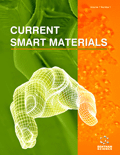Abstract
Background: Electrorheological (ER) fluids are composed of polarizable particles dispersed in insulating oil. The creep-recovery test can be applied to ER fluids to reveal the viscoelastic response of the dispersed particles which depend on conductivity of particles, amount of applied stress, magnitude of electric field strength, and particle volume fraction. In this study, ER properties of the Polyaniline/bentonite (PAni/BNT) particles, dispersed in silicone oil (SO), were investigated as functions of electric field strength (E), shear rate, shear stress, temperature, and frequency. Further, to determine the viscoelastic deformations of the ER fluid, creep and creep-recovery tests were also applied to the dispersion under external electric field strength.
Methods: PAni/BNT conducting composite was synthesized by in situ chemical oxidative polymerization method and characterized by FTIR, UV-vis, TGA, SEM, apparent density, particle size, temperature- dependent conductivity (85-400K) and zeta (ξ)-potential measurements. To determine the ER and viscoelastic behaviors of the ER fluid, Thermo-Haake RS600 Rheometer (Germany) was used. Results: PAni/BNT conducting composite was successfully synthesized and its' structure and morphology were confirmed by FTIR and SEM analyzes. Thermal stability of PAni/BNT was observed to increase with the inclusion of BNT clay. Conductivity of the composite was found to be in semiconducting range which is suitable for ER measurements. ξ-potential results in SO revealed that the colloidal stability of PAni/BNT was enhanced to +44 mV which is high enough for an ER material. PAni/BNT was found to be sensitive to the external electric field strength, exhibiting a typical shearthinning non-Newtonian viscoelastic behavior. The changes of G´ and G´´ with frequency showed that PAni/BNT composite behaves as viscoelastic material having vibration damping capability under the influence of electric field strength at elevated frequencies. Creep and creep-recovery tests revealed that PAni/BNT shows viscoelastic deformation with 55% recovery under E = 2 kV/mm condition. Conclusion: The structure of PAni/BNT composite was characterized by various technics. The ξ- potential value of PAni/BNT particles dispersed in SO medium was determined to be in colloidally stable range with +44 mV. PAni/BNT/SO dispersion exhibited phase transition from a liquid-like to a solid-like with applied electric field strength, and yield stress value observed to reach to 200 Pa under E = 2 kV/mm. Finally, creep and creep-recovery tests were applied to PAni/BNT/SO dispersion and reversible non-linear viscoelastic deformations were observed with 55% recovery under E.Keywords: Bentonite clay, colloidal dispersion, electrorheological fluid, non-polar medium, polyaniline, viscoelastic deformation.
Graphical Abstract
 17
17


